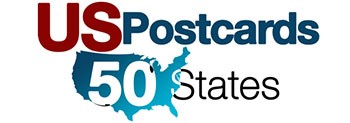Search All Categories
!Identifying the Age of Postcards
Identifying the Age of Postcards
Used with permission from J.L.Mashburn (Colonial House)
The dating of the postcard for years or eras of issue can be accurately determined if the card is studied for identity points. Research has already been done by earlier historians and guidelines have been put into place.
There were seven eras for the postcard industry and each one has distinguishing points to help establish its respective identity. The following helps determine the era of the card in question.
PIONEER ERA (1893-1898)
The Pioneer Era began when picture postcards were placed on sale by vendors and exhibitors at the Colombian Exposition in Chicago, May 1893. These were very popular and proved to be a great success. The profitable and lasting future of the postcard was greatly enhanced. The cards from this era are relatively scarce. They can be identified by combinations of the following:
- All have undivided backs.
- None show the "Authorized by Act of Congress" byline.
- Postal cards will have the Grant or Jefferson head stamp.
- Most, but not all, will be multiple view cards.
- The word "Souvenir ofÖ" or "greetings fromÖ" appear on many.
- Postage rate, if listed, is usually 2 cents.
- The most common titles will be "Souvenir Card" or "Mail Card."
- Appeared mostly in the big eastern cities.
PRIVATE MAILING CARD ERA (1898-1901)
On May 19, 1898, the government gave private printers permission to print and sell postcards. These cards were all issued with the inscription "Private Mailing Card," and today they are referred to as PMC's. It is easy to identify these because of the inscription. It may be noted that many of the early Pioneer views were reprints as Private Mailing Cards.
UNDIVIDED BACK ERA (1901-1907)
On December 24, 1901, permission was given for use of the wording "Post Card" to be imprinted on the backs of privately printed cards. All cards during this era had undivided backs of privately printed cards. All cards during this era had undivided backs and only the address was to appear on the back. The message, therefore, had to be written on the front (picture side) of the card. For this reason, there is writing on the face of many cards; this is becoming more acceptable on cards of this era.
DIVIDED BACK ERA (1907-1915)
This era came into being on March 1, 1907. The divided back made it possible for both the address and the message to be on the back of the card. This prevented the face of the card from being written on and proved to be a great boon for collectors. Normally the view colors or images filled the entire card with no white border.
WHITE BORDER ERA (1915-1930)
The White Border Era brought an end to the postcard craze era. The golden age ended as imports from Germany ceased and publishers in the U.S. began printing postcards to try to fill the void. The cards were very poor quality and many were reprints of earlier Divided Back Era cards. These are easily distinguished by the white border around the pictured area.
LINEN ERA (1930-1945)
Improvements in America printing technology brought improved card quality. Publishers began using a linen-like paper containing a high rag content but used very cheap inks in most instances. Until recently, collectors considered these cards very cheap. Now they are very popular with collectors of roadside America, Blacks, Comics, and Advertising. Views are also becoming more popular as collectors realize that this era too is a part of out history, and these cards help to illustrate the changes in the geographic structure of America.
PHOTOCHROME ERA (1939 to present day)
"Modern Chromes," as the postcard fraternity now calls them, were first introduced in 1939. Publishers, such as Mike Roberts, Dexter Press, Curt Teich, and Plastichrome, began producing cards that had very beautiful chrome colors and were very appealing to collectors. The growth of this group has been spectacular in recent years, so much so that there are now many postcard dealers who specialize only in chromes.
REAL PHOTO POSTCARDS (1900 to present day)
Real Photo postcards were in use as early as 1900. It is sometimes very hard to date a card unless it has been postally used or dated by the photographer. The stamp box will usually show the process by which it was printed---AZO, EKC, KODAK, VELOX, and KRUXO are some of the principal ones. Careful study of photo cards is essential to make sure they have not been reproduced.
Category Request
We have provided this form as a quick an easy means of contact for those who are looking to sell a collection, need to request or have questions about specific cards, or Use it to drop us a line, its a bit more convenient than e-mail.












